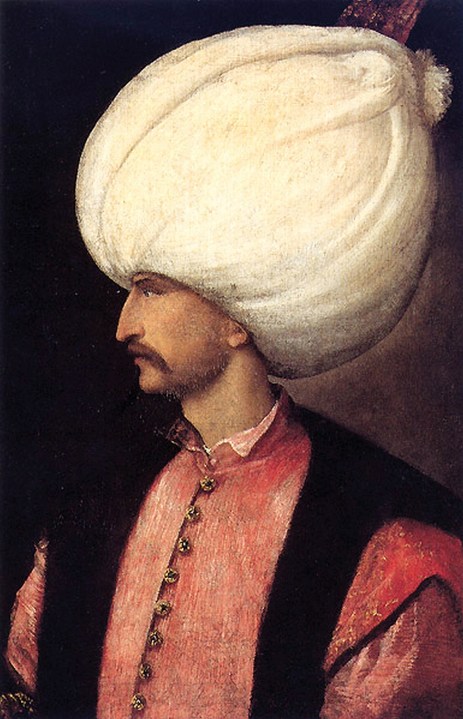
The 16th-century Ottoman ruler Sultan Suleyman liked to impose himself on foreign monarchs from the start, always beginning official letters with the uncompromising assertion: ‘I am the great lord and conqueror of the whole world.’ In this sparkling account of his middle years, the second in an ambitious three-volume biography, Christopher de Bellaigue never actually describes Suleyman as ‘the magnificent’, his most widely known epithet. But he certainly conjures up his awesome presence at home and abroad in animated prose saturated with vivid colour and detail.
So, in 1538, we encounter the sultan in his mid-forties, a swan-necked figure in a white lozenge-shaped turban, riding to war in the Balkans. Surrounded by trumpeters, kettle-drummers and white-plumed archers, he leads a well-resourced army which includes 12,000 janissaries in billowy Hungarian-style trousers. These are his murderously efficient infantrymen, who have been snatched from mainly Christian villages, raised communally as quasi-slaves and forbidden to marry, so that they owe allegiance to no one but him.
A decade earlier, he carried all before him as he extended his territory. But in 1529, after successes in Hungary, he failed to press home his advantage against his enduring rival the Holy Roman Emperor Charles V, and was beaten back from the gates of Vienna. Now, in 1538, he was on the march again. Angered by Portuguese incursions in the Indian Ocean, which he regarded as his backyard, he (or rather his henchman, the eunuch Hadim Suleyman, who had made a good job of governing Egypt) mounted an invasion of Gujarat. Although unsuccessful there, the Ottomans at least managed to consolidate their positions in Yemen and the Red Sea.
Westward, Suleyman saw opportunities for expansion in eastern Europe. Charles V also had an interest there through his brother Ferdinand, who had assumed the thrones of Bohemia and Hungary by marrying Ann, the daughter of the King of Hungary. But Suleyman’s main goal was the Mediterranean and its valuable trade routes. In a mishmash of shifting alliances, made more unstable by religious divisions related to the Reformation, he worked ceaselessly to undermine Charles through allying with Francis I of France. But his most decisive victory came at Prevesa, in the Ionian Sea, in September 1538. There, his naval commander, the fearsome north African pirate Hayreddin Barbarossa, defeated a powerful Christian fleet headed by the Genoese admiral Andrea Doria. This gave Suleyman control of the eastern Mediterranean for at least three decades.
Suleyman’s father, Selim, had a particular reputation for culling his near relations
The sultan’s foreign interventions were mirrored by equally devious and bloody intrigue on the domestic front. In 1533, his principal concubine, Mahidevran, the mother of his first son, Mustafa, was superseded, amid much scratching and hair-pulling, by the Ruthenian-born Christian convert Roxelana, or Hürrem (meaning ‘happy’). She enjoyed the unusual position (in Ottoman terms) of being the sultan’s cherished wife, and bore him five sons. For that status she was titled Haseki or ‘special friend’.
In the late 1540s, Suleyman began spending more time at his palace in Edirne in the western (Thracian) part of modern Turkey, a town whose climate he preferred to Istanbul. Now more sober in lifestyle, he no longer sported bejewelled caftans of crimson silk and satin but wore wool and cotton. State affairs were left largely to the Bosnian-born Rustem Pasha, who had risen from nothing to become grand vizier through ruthless efficiency and patronage. He was notoriously tight-fisted, but at least the regime was solvent. Also, he had married Mihrimah, the sultan’s daughter by Hürrem. This created a powerful lobby, known as the cabal, whose objective was to ensure that one of Hürrem’s sons succeeded Suleyman.
Succession was one of the more bizarre Ottoman rituals and de Bellaigue treats it skilfully. The office of sultan did not pass seamlessly to the eldest son. Surviving heirs had to jockey for position and try to kill each other. Suleyman’s father Selim had a particular reputation for culling his near relations. In this febrile atmosphere, the prospective heir was often made governor of somewhere near Istanbul, so that he could outrace any rival and hurry to the capital to claim the throne on the incumbent’s death. With this in mind, Rustem had Mahidevran banished to distant Amasya in northern Anatolia, close to the Black Sea, thus diminishing the succession chances of her son Mustafa, who accompanied her.
But Mustafa remained popular, notably with the janissaries, while Hürrem was not. When, in 1553, he was invited to join his father at the start of a military campaign against the resurgent Safavids, he was suitably wary. But what he wasn’t prepared for was a barrage of abuse from his father, accusations of sedition and treason and finally garotting by three mutes who were part of his retinue.
De Bellaigue’s darting, episodic style is unusual but effective. His use of the historic present tense puts the reader directly onto battlefields, inside council chambers and often at the heart of Suleyman’s thought processes. It is not obvious why he has chosen to tackle the sultan’s life in three volumes (he says nothing of methodology). But the dramatic details have an uncanny power of sticking in one’s mind in ways that would definitely be lost in a more traditional narrative.








Comments